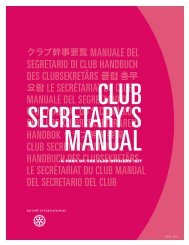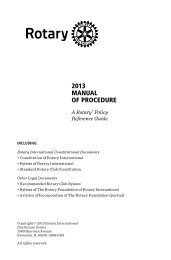DISCURSOS - Rotary International
DISCURSOS - Rotary International
DISCURSOS - Rotary International
Create successful ePaper yourself
Turn your PDF publications into a flip-book with our unique Google optimized e-Paper software.
Leadership<br />
Clifford L. Dochterman<br />
Past RI President<br />
What kind of leadership will you give to the club presidents, secretaries, and district committees<br />
in your district next year?<br />
Google lists over 4 million entries on leadership. But I don’t believe there is one on the leadership<br />
of a <strong>Rotary</strong> district governor. There are so many different styles of leadership. However, your<br />
leadership job is unique because you are leading a group of Rotarian volunteers. What is the<br />
leadership style of a successful district governor?<br />
A district governor won’t survive very long using the leadership style of a top sergeant — I don’t<br />
think those club presidents will line up for marching orders.<br />
A district governor will not be effective using the leadership skills of an animal trainer, whose<br />
tools are a whip and a chair.<br />
A district governor will not find much success using the techniques of a football coach yelling instructions<br />
to players in a championship game.<br />
The skills of a successful district governor working with volunteer Rotarians require some special<br />
consideration. You can be sure there is no chance to fire them and hire a new group.<br />
Over the years, I have observed that some of the most effective <strong>Rotary</strong> leaders are those who<br />
exhibit the leadership skills and temperament of a symphony orchestra conductor. Just as your<br />
district leaders and club presidents are composed of a wide variety of men and women with<br />
unusual abilities, special interests, and many experiences, a symphony orchestra is made up of<br />
many separate instruments and individual artists.<br />
First is the string section, with violins and cellos. I would compare them to those Rotarians who<br />
are so important to your district but are often rather high-strung and frequently need to be tuned<br />
in to the issues at hand.<br />
Over here is the woodwind section of clarinets, oboes, and bassoons, which have to cover a<br />
wide range in the musical score. In <strong>Rotary</strong>, the woodwinds might be the quiet members of your<br />
leadership team, who are perfectly willing to repeat the theme of the year. Once in a while, you<br />
might hear a squeak or two from that section.<br />
Then over here is the orchestra’s brass section — the trumpets, trombones, and tubas. These<br />
are similar to the Rotarians you can always hear, loud and clear. When they toot their horns, you<br />
know they have an opinion — clearly expressed. Then occasionally, if it’s the tuba guy, the only<br />
sound may be an “oomph.”<br />
In the back of our orchestra is the percussion section, with drums, cymbals, and all the bells and<br />
whistles. There may be big timpani, or kettledrums, which you only hear once or twice. I suspect<br />
every <strong>Rotary</strong> club has a percussion section, whose members beat the drum for their pet projects<br />
or use a drumroll to announce their arrival. You can’t miss the percussion section in any club.<br />
In every orchestra there are those who are behind the scenes — the stagehands. They build the<br />
risers, set the chairs, and handle the lighting and sound effects. In your <strong>Rotary</strong> district, they are<br />
the faithful members you can always count on being there and doing the routine tasks. They are<br />
<strong>International</strong> Assembly Speeches 2013 47



![La présidence du club [222-FR] - Rotary International](https://img.yumpu.com/25855726/1/190x245/la-presidence-du-club-222-fr-rotary-international.jpg?quality=85)











![La conférence de district [800-FR] - Rotary International](https://img.yumpu.com/25855636/1/190x245/la-conference-de-district-800-fr-rotary-international.jpg?quality=85)
